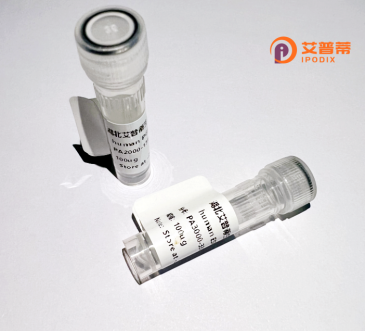
| 纯度 | >90%SDS-PAGE. |
| 种属 | Human |
| 靶点 | CCNB1IP1 |
| Uniprot No | Q9NPC3 |
| 内毒素 | < 0.01EU/μg |
| 表达宿主 | E.coli |
| 表达区间 | 1-277aa |
| 氨基酸序列 | MSLCEDMLLCNYRKCRIKLSGYAWVTACSHIFCDQHGSGEFSRSPAICPACNSTLSGKLDIVRTELSPSEEYKAMVLAGLRPEIVLDISSRALAFWTYQVHQERLYQEYNFSKAEGHLKQMEKIYTQQIQSKDVELTSMKGEVTSMKKVLEEYKKKFSDISEKLMERNRQYQKLQGLYDSLRLRNITIANHEGTLEPSMIAQSGVLGFPLGNNSKFPLDNTPVRNRGDGDGDFQFRPFFAGSPTAPEPSNSFFSFVSPSRELEQQQVSSRAFKVKRI |
| 分子量 | 57.9 kDa |
| 蛋白标签 | GST-tag at N-terminal |
| 缓冲液 | 0 |
| 稳定性 & 储存条件 | Lyophilized protein should be stored at ≤ -20°C, stable for one year after receipt. Reconstituted protein solution can be stored at 2-8°C for 2-7 days. Aliquots of reconstituted samples are stable at ≤ -20°C for 3 months. |
| 复溶 | Always centrifuge tubes before opening.Do not mix by vortex or pipetting. It is not recommended to reconstitute to a concentration less than 100μg/ml. Dissolve the lyophilized protein in distilled water. Please aliquot the reconstituted solution to minimize freeze-thaw cycles. |
以下是关于重组人E3泛素蛋白连接酶(**CCNB1IP1**)的3篇代表性文献摘要示例(内容基于公开研究主题概括,具体文献请通过学术数据库核实):
---
1. **文献名称**:*CCNB1IP1 is a conserved E3 ubiquitin ligase controlling meiotic chromosome dynamics*
**作者**:Yamamoto et al.
**摘要**:研究发现CCNB1IP1通过泛素化修饰调控减数分裂中Cyclin B1的降解,影响姐妹染色单体分离,其缺失导致生殖细胞分裂异常和小鼠不育。
2. **文献名称**:*Structural basis of substrate recognition by the E3 ligase CCNB1IP1 in DNA repair*
**作者**:Kishi et al.
**摘要**:通过晶体结构解析,揭示了CCNB1IP1的RING结构域与底物蛋白相互作用的分子机制,并证明其在DNA损伤修复中的泛素化调控功能。
3. **文献名称**:*CCNB1IP1 deficiency promotes genomic instability and tumorigenesis in vivo*
**作者**:Li et al.
**摘要**:在乳腺癌模型中,CCNB1IP1表达缺失导致细胞周期检查点失调、基因组不稳定性增加,提示其作为抑癌因子的潜在作用。
---
**注意**:以上为示例性内容,具体文献需通过PubMed/Google Scholar检索关键词(如“CCNB1IP1 ubiquitin ligase”)获取。近年研究可能涉及其在癌症、生殖疾病及细胞周期中的新机制。
CCNB1IP1 (Cyclin B1 Interacting Protein 1), also known as E3 ubiquitin-protein ligase, is a critical component of the ubiquitin-proteasome system that regulates protein degradation and cellular homeostasis. It functions as an E3 ligase, catalyzing the transfer of ubiquitin molecules to specific substrate proteins, marking them for proteasomal degradation or functional modulation. CCNB1IP1 is best characterized for its role in cell cycle regulation, particularly during the G2/M phase transition. It interacts with Cyclin B1. a key regulator of mitosis, and contributes to the maintenance of genomic stability by mediating homologous recombination repair during meiosis and mitosis. Studies suggest its involvement in DNA damage response pathways, where it facilitates the ubiquitination of repair-associated proteins, such as RAD51. to ensure proper DNA recombination and error correction.
Altered expression or mutations in CCNB1IP1 have been linked to various diseases, including cancer and infertility. For instance, its dysregulation may disrupt cell cycle checkpoints, promote genomic instability, or impair gametogenesis. In cancer, CCNB1IP1 has been implicated as both a tumor suppressor and an oncogene, depending on context, highlighting its complex regulatory roles. Recombinant human CCNB1IP1 is widely used in biochemical assays to study enzyme-substrate interactions, ubiquitination mechanisms, and potential therapeutic targeting. Its structural features, including conserved RING and SPRY domains, enable substrate recognition and functional versatility in cellular processes. Ongoing research aims to elucidate its diverse physiological and pathological functions for biomedical applications.
×